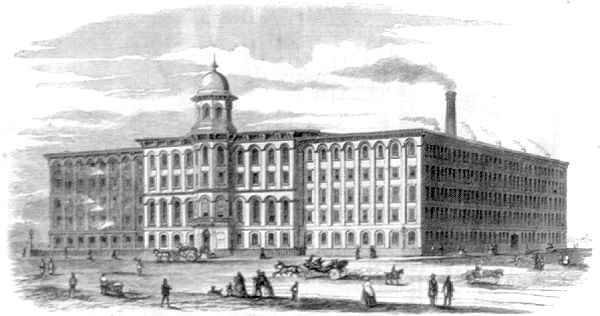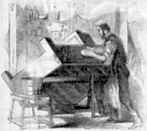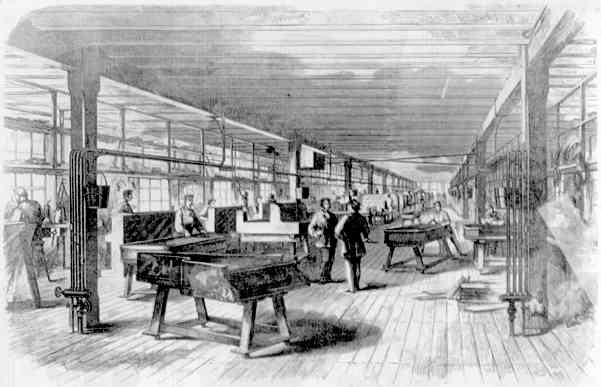
EXTERIOR VIEW OF MESSRS. CHICKERING'S PIANOFORTE MANUFACTORY, TREMONT STREET, BOSTON, MASS.
 EXTERIOR VIEW OF MESSRS. CHICKERING'S PIANOFORTE MANUFACTORY, TREMONT STREET, BOSTON, MASS. |
 SAWING THE ROUGH PLANKS |
|
 SAWING AND PLANING THE BOARDS |  SKELETON MAKING |
 DRYING THE WOOD BY MEANS OF STEAM PIPES |
 BRONZING AND PRE- PARING THE PLATES |
THE MANUFACTURE OF PIANOFORTES.
Chickering & Co.
The importance of this branch of manufacture in the United States can hardly be estimated. Those who live in our large cities can arrive at some approximate estimate, for he sees in every house he visits a pianoforte. But if he travels from State to State he becomes thoroughly impressed with the magnitude of the traffic in this branch of industry, for in the citizen's brick house, in the squatter's log-cabin, in the newly-settled village, and in the heart of the wildest districts, the pleasant tone and the compositions of the piano will alike be found. In their manufacture millions of dollars are invested, and tens of thousands of hands employed ; these receive good living wages, and are among the most respectable of our mechanics.
The progress of the pianoforte to perfection has been very slow, but its family tree is well defined, and its genealogy is traceable for [] antiquuity. Small in its beginnings, centuries before the Christian Era, for thousands of years it changed but little in its form and gained scarcely anything in power. It is only within the last hundred years that the instrument we now call the pianoforte has been developed to the present point of power and utility.
No exact type in form of the modern piano has ever been discovered, the only traceable resemblance is in its fundamental principle, the production of musical tone by striking with some
 CHICKERING'S PIANOFORTE MANUFACTORY - VARNISHING ROOM |
 WARE ROOMS |  RUBBING THE CASE WITH PUMICE STONE |
substance upon wires or strings fastened at each end. For centuries the principal change will be found to consist merely in the substitutions of one striking substance for another.
The initial idea of the pianoforte was undoubtedly the Greek psalterion or [typanium]. This instrument was merely a box, across which strings or wires were stretched, and tuned according to the imperfect scales then in use by that people. Tone was produced by striking the string with two small hammers. This instrument was very generally used by the Hebrews, and constant mention is made of it in contemporary writings and in the sacred book.
 FRET AND JIG SAWING |
 GLUING BRIDGES AND [PLACING] SOUNDING BOARDS |
The dulcimer was of the same facility, but the earliest approach to the primitive idea of the pianoforte was the old clavichord, for in that instrument a keyboard was applied for the first time. By means of this keyboard small plates of copper were set in motion and acted upon the strings. Then came the clavicitherium, with catgut strings acted upon by soft leathern hammers. This, as may be imagined, was a terrible instrument, and the tone would not have borne resemblance to any known sound.
The virginal, so celebrated as being the special favorite of Queen Elizabeth, was another feeble attempt to make something out of a good idea ; but what could be got in the way of music from metallic strings set in motion by the points of quills fixed to the ends of levers? The same poverty in the mechanical construction was observable in the spinet ; it was just as imperfect an instrument as the virginal, but in form the case bore close resemblance to that of our early square piano.
 ACTION ROOM |
 POLISHING CASES, &C. |
The father of the grand piano was the harpsichord, but although the mechanism of the action was many steps in advance of its predecessors, like the virginal and the spinet, still, like these, the strings were acted upon by quills. This instrument was first known early in the eighteenth century, and upon that miserable and insufficient instrument Sebastian Bach, Beethoven, Handel, Clementi, Mozart, and others, whose names add dignity to the history of music, poured forth their divine inspirations.
The eighteenth century is [remarkable] among other things for the wonderful strides made in the manufacture of pianofortes. The principles were then evolved opon which our makers of the nineteenth century have built up their present almost perfect system.
A Frenchman named Marius fist substituted hammers for quills, then a Florentine named Christophoro greatly improved upon the innovations of Marius, and added to the capacity of the instrument the power of playing soft as well as loud, and on this fact the instrument was called piano (soft) forte (loud).
 REGULATING THE HAMMERS |  TRIMMING AND FINISHING |
In 1768 the most successful pianoforte manufacturer in the world was Zumpe, of London. His instruments had a vast reputation, and were in demand all over the continent ; but he soon found rivals in Germany and Paris in the well-known Silbermann and the still [] famous Erards. These, with Clementi and Kirkman, and the Broadwoods of London, with a few lesser stars, were the piano makers of the world.
It is only within the last quarter of a century that America has taken any rank among the nations in the manufacturing of pianofortes. The movement in this direction certainly received its most direct and powerful impulse from the perseverance, energy and skill of the widely esteemed Jonas Chickering, of Boston.
Jonas Chickering commenced business somewhere about 1820, and so successful was he in producing the sweetest sound and pleasantest actioned piano, that in a few years his name became a sort of household word throughout the United States For thirty-seven years the vast business built up and sustained by the energy and integrity of Jonas Chickering has gone on increasing, until now it is literally the mammoth establishement
 CHICKERING'S PIANOFORTE MANUFACTORY - FINISHING ROOM |